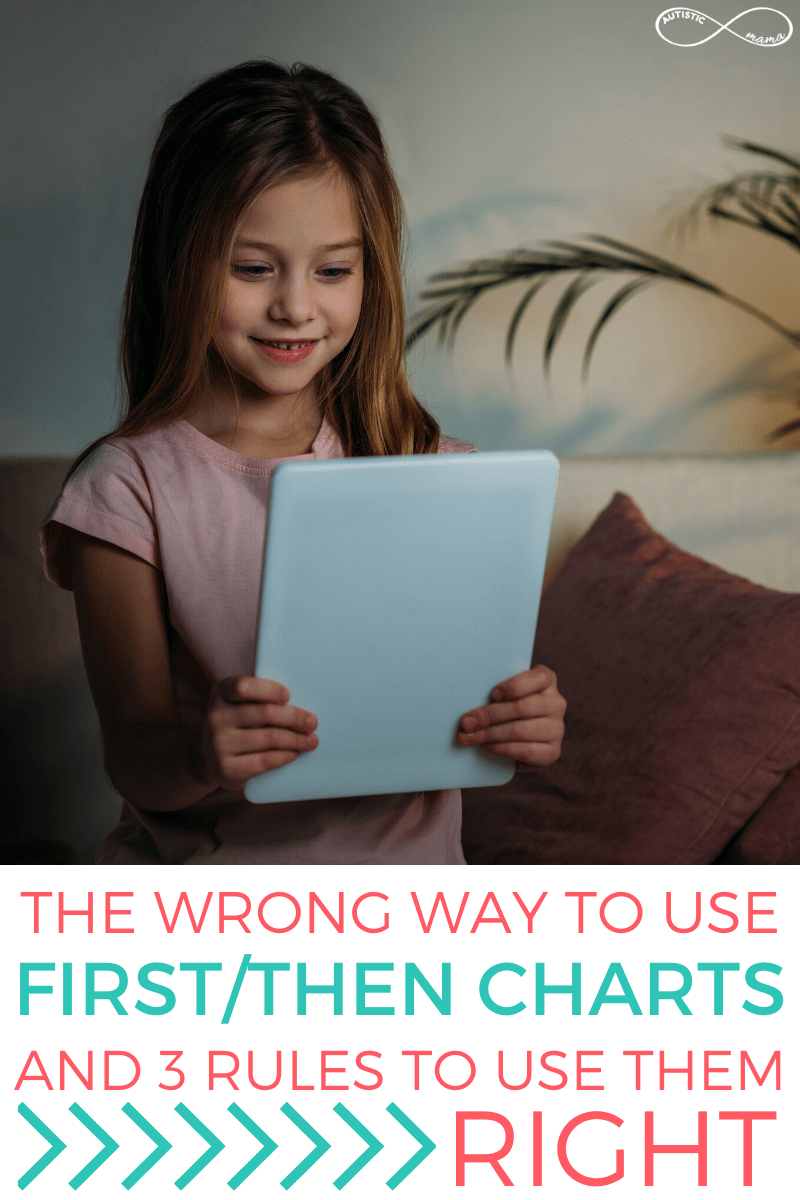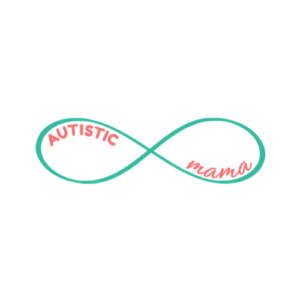First/Then Charts…
I’m sure that you’ve seen them… In classrooms and in therapy offices, maybe even at your house.
And there’s a lot to unpack with First/Then Charts…
Because here’s the thing: They can be extremely helpful or they can also be extremely harmful.
See, there is a definite ‘wrong way’ to use First/Then Charts… And unfortunately, it’s the most popular way to use First/Then Charts with Autistic Kids.
But should we throw the baby out with the bathwater? Well, that’s what we’re going to dive into today.
The Right and Wrong Way to Use First/Then Charts for Autistic Children

(Prefer video? This post is available in video format below)
The Wrong Way to Use First/Then Charts for Autistic Children
Here’s how First/Then Charts are typically used…
You want your autistic child to do something that they don’t want to do.
In order to get them to do that activity, you’re going to say ‘first do the thing I want you to do that you don’t want to do, then you get to do the thing you want to do’.
An example of a traditional First/Then Chart like this would be:
First you do your math homework, and then you get your tablet.
The idea behind it is first the child does the ‘non-preferred activity’, and then they’re rewarded with the ‘preferred’ activity.
You might hear it compared to adults who go to work, and then they get a paycheck.
This, my friend, is the wrong way to use First/Then Charts.
Essentially what this practice does is something called ‘compliance training’.
It teaches children to do what is asked of them, regardless of their reason for not wanting to do it.
It’s a behaviorist technique often used in ABA Therapy, and it can have detrimental effects on kids.
You can read more about why ABA is harmful and about how to help with autistic children’s behaviors respectfully in these posts:
- What’s the Big Deal with ABA Therapy?
- 5 Important Reasons Even “New” ABA is Problematic
- The Missing Piece in Most Autism Behavior Plans
- Do This BEFORE Addressing Your Autistic Child’s Behaviors
The Right Way to Use First/Then Charts for Autistic Children
Okay, so we know that the traditional use of First/Then Charts is out… How can we use them while parenting our autistic children?
I use First/Then Charts in a bunch of ways:
- To communicate a plan
- To simplify a transition
- To ease anxiety in new scenarios
- To help with turn-taking
First/Then Charts are a great way to explain a plan in a clear and concrete way to autistic children. It makes the plan more accessible and easier to understand and remember.
But I will warn you… It can be really easy to fall back into using First/Then Charts the wrong way.
So if you’re going to use them with your autistic child, it’s vital that you remember the three rules I’m about to share with you and check back in with them often just to make sure you aren’t falling back into a compliance/reward situation.
With that said, let’s jump in to the three rules for using First/Then Charts the right way!
#1 “First” Should Not be an Activity the Child Refuses to Do
The “first” in a First/Then Chart should not be an activity the child refuses to do.
Now I know you might be thinking… Isn’t that the point of First/Then Charts? To get them to do a non-preferred activity?
Not my First/Then Charts! We’re about communicating a plan.
And if your autistic child is refusing to do an activity, your job as the parent isn’t to use rewards to get them to comply with the activity.
Your job is to dig under the surface and find out why they’re refusing the activity, and then find ways to help them be successful.
But that’s a whole ‘nother blog topic, friend! Let’s get back to First/Then Charts…
The “first” on a First/Then Chart should purely be to communicate what happens first.
- First shoes, Then car.
- First lunch, Then park.
- First school, Then Grandma’s.
The “first” is quite simply what happens first in the plan.
#2 “Then” Should Not be an Activity the Child Doesn’t Normally Get to Do
The “then” on a First/Then Chart should not be a treat or activity that the child doesn’t normally get to do.
Let’s go back to that traditional First/Then Chart from the wrong way to use these… ‘First homework, then tablet’
If your child doesn’t typically get to play with their tablet, it shouldn’t be the ‘then’ on a First/Then chart.
That gets you squarely in reward/bribe territory, and that’s not where we want to be.
Remember, we are communicating a plan. We aren’t trying to alter a behavior or get our child to do something they have refused to do.
So “then” is simply what happens next in the plan.
#3 “Then” Should Not be Dependent on “First”
Now this rule may be the absolute most important when it comes to using First/Then Charts the right way…
The “then” should not be in any way, shape, or form dependent on the “first”.
What do I mean by that? Let’s dive into an example:
First school, Then Grandma’s.
Notice that it doesn’t say:
- First get through the entire school day.
- First don’t get a call home from the teacher.
- First go to school without a meltdown.
Nope. Just first school. School is what happens first.
So often with First/Then Charts we can fall into the trap of using them as rewards, or on the flip side, as consequences.
“Well we were GOING to go to Grandma’s, but since you had a meltdown on the bus, now we can’t.”
“Well we were GOING to go to the park after lunch, but you refused to finish your grapes.”
“Well we were GOING to watch a movie after we finished homework, but you had a bad attitude.”
Nope, nope, nope friends.
If you don’t know that the “then” will happen, it doesn’t belong on a First/Then Chart.
The goal is to avoid manipulating our kids.
And I’ll say it for like the 84th time… First/Then Charts are to communicate a plan, not to get our kids to do something they don’t want to do.
So there you have it.
If you want to use First/Then Charts with your autistic child, keep these three rules in mind:
- “First” Should Not Be an Activity Your Child Refuses to Do
- “Then” Should Not Be an Activity Your Child Doesn’t Normally Get to Do
- “Then” Should Not Be Dependent on “First”
Reading this and thinking…
Okay, Kaylene, but if I can’t use First/Then Charts to get my kids to do what I need them to do… What CAN I do?
Or but Kaylene, without rewards I wouldn’t be able to parent…
Or how the heck do I practically implement this in real life when I need my kids to do their homework?
You are not alone.
See, it’s my job to help parents of autistic children just like you feel empowered and ready to parent and advocate for your autistic child with the autistic guidance and support that you need.
If you’re interested in how we can work one on one together, click here to book a call and see if we’re a good fit for coaching.
But if you are looking for group support with a community of parents just like you and a team of autistic mentors to guide you through every step of your autism jourey, make sure you’re on the waitlist for Autism Journey Collective.
The doors are closed now, but we’re opening again soon! Click here to join the waitlist.
If you loved this post, you might also enjoy…
5 Important Steps to Discipline an Autistic Child

The Parent’s Guide to Understanding Autism Meltdowns


You are really helpful, I am a mother of lily who is autistic, her final assessment is tomorrow. When CAMHS first suggested Lily age 15 may be Autistic, I felt a huge rush of relief and Joy. I had briefly considered it myself but not knowing anything about it, I was also the feed back was very dismissed, don’t label lily! But I knew she was suffering so badly at school I took her out of her school. All the times I had forced her in to school, as I was always told I was coddling her and I must be very strict.i feel bad. But feel so blessed to have lily and wouldn’t change her, just want to help my daughter. Thank you so much, really appreciate you guidence.